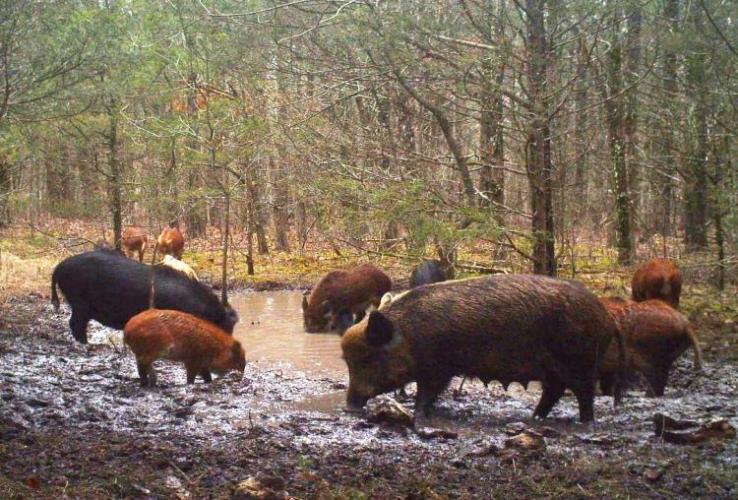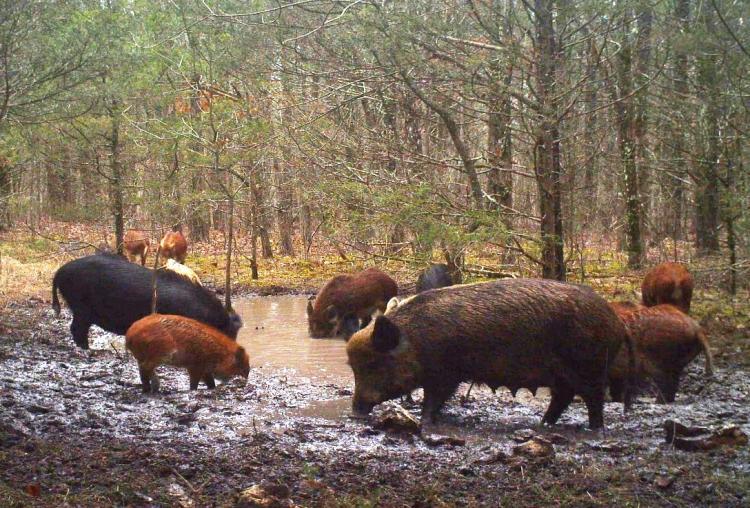
Xplor reconnects kids to nature and helps them find adventure in their own backyard. Free to residents of Missouri.


































Stay in Touch with MDC news, newsletters, events, and manage your subscription

Xplor reconnects kids to nature and helps them find adventure in their own backyard. Free to residents of Missouri.

A monthly publication about conservation in Missouri. Started in 1938, the printed magazine is free to residents of Missouri.


JEFFERSON CITY, Mo. – Missouri Department of Conservation (MDC) wildlife biologists on the feral hog strike team have tallied up numbers for 2016. The year yielded a total of 5,358 feral hogs removed by MDC, partner agencies, and private landowners, which is a significant increase over efforts the previous year. In 2015, 3,649 feral hogs were removed from the landscape.
Some attributing factors in the increase include MDC’s “Report, don’t shoot” message to encouraging trapping, banning hog hunting on conservation areas, and a strong public awareness campaign.
Southeast Missouri trapped 2,941 feral hogs, which is where the highest density of feral hogs occurs. The Ozark region trapped 1,293 while the Southwest region trapped 1,006 hogs. St. Louis, Central and Kansas City regions all trapped fewer than 100 feral hogs each.
Alan Leary, MDC’s Wildlife Management Coordinator and leader of the Department’s feral hog eradication efforts said although the goal is to eradicate feral hogs in the state, a more immediate goal is to keep the feral hog population from spreading to those northern regions.
“We made significant progress in 2016,” said Leary. “The key to eradicating these destructive, invasive pests is cooperation with private landowners and partners in efforts to report hog sightings, continue trapping and deter hog hunting and the illegal release of hogs.”
In 2016, MDC partnered with other conservation groups, agriculture organizations, and the Missouri Conservation Heritage Foundation to provide the state's feral hog strike team with more trapping equipment for use on both private and public land, and to fund public education efforts on the dangers of feral hogs. MDC increased communication efforts, bolstering an already active feral hog communications campaign with statewide media efforts on agricultural news stations. Through this campaign, the public heard from private landowners who suffered hog damage and are working with MDC and USDA to eradicate feral hogs. They also helped spread the message to “Report, don’t shoot” feral hogs.
“The majority of land in Missouri is privately owned, so it’s crucial that we engage the public, educate them on the dangers of feral hogs and engage them in our trapping efforts,” Leary said. “Through our communications campaign, more landowners are learning more about feral hogs, asking for help and ridding their property of this invasive species.”
Landowners are also learning that it’s much easier to get rid of feral hogs if you trap the whole sounder, rather than allow hunting and only shooting one or two, he said.
While hunting is a very effective tool for managing populations of wildlife, feral hogs are not wildlife and the goal is to remove them. Killing feral hogs for sport hinders efforts to eradicate them for several reasons.
“Some hunters intentionally release feral hogs in new areas to establish populations to hunt and hunters usually only shoot one or two hogs out of the group, while the rest scatter across the landscape and become more difficult to catch,” Leary said. “Hunting actually compounds the problem.”
While trapping is an effective method for eradicating feral hogs, when it comes to the remaining few of a sounder they are difficult to eliminate. Feral hogs are great at noticing details that tip them off to avoid a trapping area. They have coloring that blends into the landscape and hide in thickets and dense cover. Therefore, in the winter when trees are bare, MDC occasionally uses aerial gunning to reach the ultimate goal of removing this elusive, invasive animal from the landscape. Through the combination of these different techniques, MDC’s feral hog team made significant progress in eradicating feral hogs last year.
“It’s vital we continue our efforts and get the feral hog population under control before it spreads any further,” Leary said.
Feral hogs are not wildlife and are a serious threat to fish, forests and wildlife as well as agricultural resources. Economic losses resulting from feral hog damage in the U.S. is estimated at greater than $1.5 billion per year. Feral hogs damage property, agriculture, and natural resources by their aggressive rooting of soil in addition to their trampling and consumption of crops as part of their daily search for food.
Feral hogs have expanded their range in the U.S. from 17 to 38 states over the past 30 years. Their populations grow rapidly because feral hogs can breed any time of year and produce two litters of one to seven piglets every 12 to 15 months. Feral hogs are also known to carry diseases such as swine brucellosis, pseudorabies, trichinosis and leptospirosis, which are a threat to Missouri agriculture and human health.
To report feral hog sightings or damage, go online to mdc.mo.gov/feralhog.